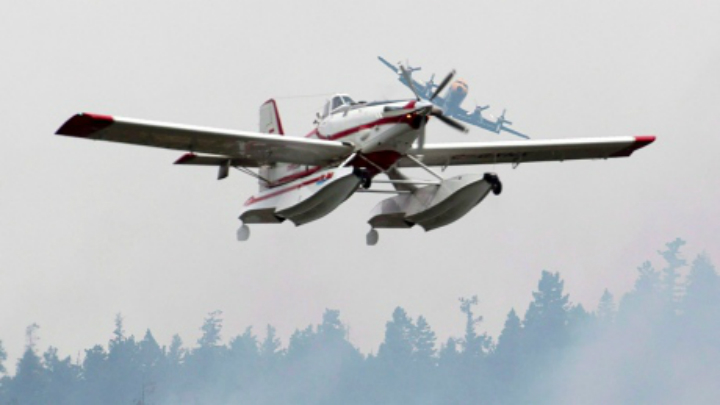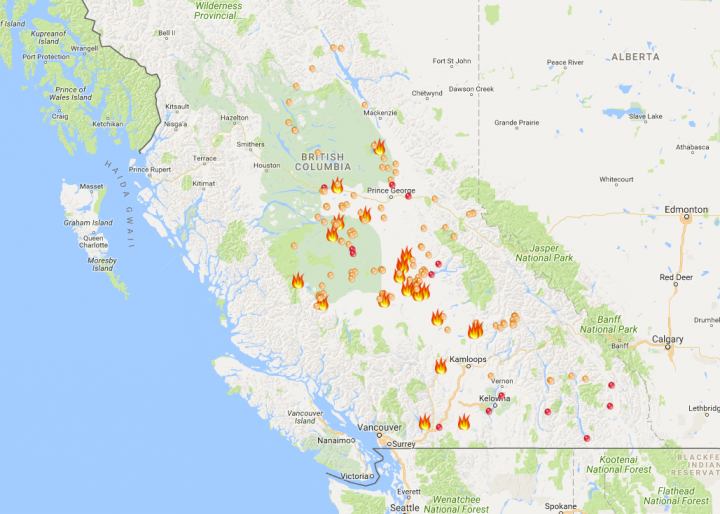
Twelve new wildfires started in B.C. on Tuesday, a number that is down significantly over the past few days due to a change in weather.
Kevin Skrepnek, B.C.’s Chief Fire Information Officer, said 183 fires are burning across the province.
“We haven’t had a whole lot of lightning,” Skrepnek said. “What lightning we have seen has come with rain so that has kept the fires in check as well as an exceptionally robust initial attack response from our crews.”
There have been 602 wildfires since April 1, which have burnt 78,000 hectares. Skrepnek said the number of estimated hectares burned has gone up from Tuesday due to more accurate mapping, especially for fires in remote areas.
“We continue to see aggressive fire behaviour out there, especially for fires that are burning in fairly thick timber,” Skrepnek said.
The Ashcroft-Cache Creek fire is estimated to be 10, 304 hectares and the Princeton fire is estimated to be 2,700 hectares. The Gustafsen wildfire west of 100 Mile House is now estimated to be 5,000 hectares in size and the Wildwood fire to the northeast of Williams Lake is estimated to be 2,500 hectares.
A map of the wildfires in B.C. The flames indicate fires of note, while the red dots are for new fires, less than 24 hours old, and the yellow dots are for active fires.
“There have been a number of offers of assistance from volunteers wanting to join the firefighting efforts,” Skrepnek said. “We appreciate those offers but this is a job best left to professionals and we’re going to be relying on that both through our own contingent of firefighters, as well as some of the staff from out of province as well as the forest industry.”
Skrepnek said they are expecting hot, dry conditions to continue across southern B.C. and people should follow any evacuation orders that are in place. He also said individuals on lakes are interfering with firefighting efforts. This includes wind surfers, kayakers and boaters who are preventing air tankers from landing to fill up with water.
According to Skrepnek, while additional aircraft has been brought in from other provinces, the Martin Mars water bomber is not being used.
“There’s more modern and cost effective aircraft available and that’s what we have brought in to augment the fleet we already got,” Skrepnek said.
“The Mars is an iconic aircraft and I recognize people have a lot of nostalgia and respect for it quite frankly. It has been fighting fire in this province for decades but there’s simply more effective aircraft available. It’s our understanding as well that the Mars is currently being repaired and wouldn’t be operationally ready until mid-August.”
Robert Turner, assistant deputy minister of Emergency Management BC, said 150 fire departments within British Columbia have offered assistance and 22 have sent resources.
Turner said the number of people who have evacuated their homes have remain unchanged from Tuesday. There have been 7,886 people registered at reception centres and 3,500 people are using lodging, primarily around Prince George.
First Nations have authority to issue their own evacuation orders.
Staff Sgt. Annie Linteau from the B.C. RCMP said they tell all members of the public, including First Nations, about the risks of staying in the area.
“If a person has the ability to make their own decision and they are over the age of 19, we will not force them to leave the home,” Linteau said.
“The only time we may intervene is if there are children on that property, in which case we have a duty to protect them, and they could potentially be removed the property.”
However, Linteau said there have been no children that have been removed from any properties.
“RCMP First Nations policing officers are continuing to engage with the community and engage in a dialogue,” Linteau said, adding that removing children would be a last resort.
RCMP response
Linteau said resources are continuing to come from all across the province to the B.C. Interior to help local RCMP officers.
“They are engaged in a variety of duties. Of course, they are assisting with the evacuation orders,” Linteau said. “They are also conducting 24 hour patrols of evacuated neighbourhoods. They are managing traffic congestion, road safety and general emergency response.”
READ MORE: RCMP arrest alleged looters in B.C. evacuation areas
Linteau said they are investigating separate incidents of criminal activities within evacuation areas.
“It’s always possible that certain properties could be affected by criminal activity and we invite anyone who sees suspicious activity to phone their local police department immediately.”
Skrepnek said they are also aware of photos of workers in Ministry of Forests, Lands and Natural Resource Operations uniforms gathered around a campfire near Adams Lake in B.C.’s Shuswap region that are circulating on social media, and added the ministry is taking the matter seriously.
“We are going to be investigating,” Skrepnek said.
“There is an open burning and campfire ban in place across the entire province and that ban applies to everyone.”
Saanich Fire Department joins firefighting efforts
The Saanich Fire Department is sending a fire engine and four firefighters to Williams Lake to help with structure protection, as well as to help fight structure fires.
“We want to get there safely and we will be in a staging area where we’ll be deployed from there,” Robert Heppell, a captain with fire supression division of the Saanich Fire Department, said
The Sidney Fire Department and the Maritime Forces Pacific also sent resources to the B.C. Interior.
CC-130J Hercules takes off from CFB Comox to deliver equipment to Bella Coola in support of #OpLENTUS #CAF…
Posted by Maritime Forces Pacific / Forces maritimes du Pacifique on Tuesday, July 11, 2017
E1 crew on route to Williams Lake after a night of sleeping under the stars in Cache Creek. #BCWildfires #sidney #InItTogether pic.twitter.com/kD67Iu7Qil
— SidneyVFire (@SidneyVFire) July 12, 2017





